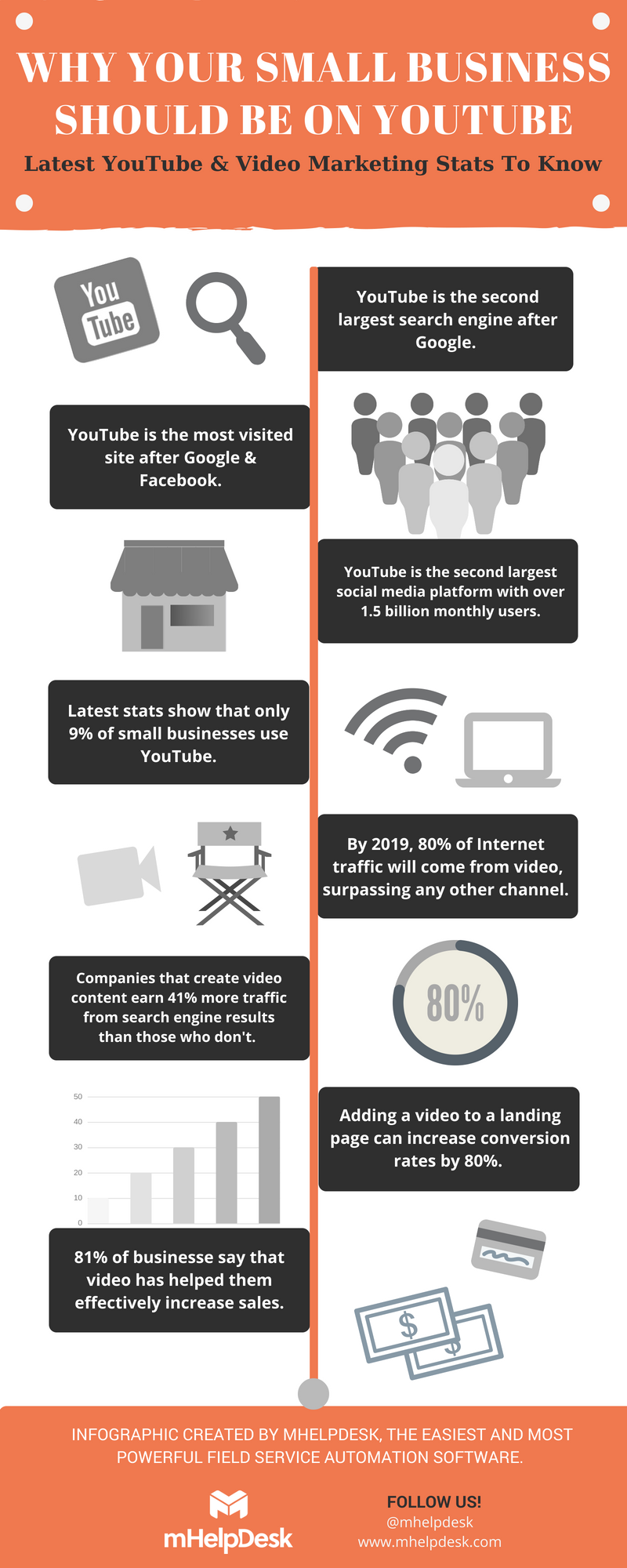“YouTube isn’t dead. It isn’t old school. It isn’t lame. YouTube is a read hot tool for search engine power, and you can benefit from using it.” – Neil Patel
There’s no denying video as a popular medium–one that’s only set to grow more and more. Are you considering video content for your small business? You should and more importantly, you should post them to YouTube. Not only is YouTube the world’s second largest search engine after Google, increasing the chances of prospects finding you on search (reminder: YouTube is owned by Google), but only a small percentage of small businesses are on YouTube. The latest stats note it at a mere 9%, giving your small business a big chance to stand out and be discovered faster than the other local businesses around you.
Need some more convincing? Our infographic below will give you more stats to show you the reach and opportunity both YouTube and video marketing present. Read on (and embrace video already)!

Like this infographic? Share it with your co-workers or network on social media!![]()
More on why your small business should be on YouTube, including some best practices for video creation and posting:
- YouTube is the second largest second engine after Google (Brandwatch). Set up your videos the right way and you’ll rank high not just on YouTube but on Google. Another plus: Google owns YouTube, so video results from YouTube are often within organic search results on Google pages. Google also favors websites with a lot of authority and YouTube ranks very high.

- YouTube is the most visited site after Google and Facebook (Brandwatch). People on average also spend over 9 minutes on YouTube, just third to Reddit (where people spend over 14 minutes) and Facebook (where people spend over 13 minutes).

- YouTube is the second largest social media platform with over 1.5 billion monthly users (Techcrunch). You don’t need a marketers’ word to tell you that’s a huge audience. To compare, Facebook has got 2 billion users and Instagram has 700 million.

- Latest stats show that only 9% of small businesses use YouTube (Merchdope.com). To optimize your videos, pay attention to your YouTube video titles and video descriptions. The first 100-150 characters are the most important and you’ll want to make sure your keyword is included there. As an example, if you are offering HVAC maintenance advice, you’ll want to include “HVAC maintenance” towards the beginning of the title and description. We recommend checking out these tips from SEO expert Brian Dean on how to get your videos to rank.

- By 2019, 80% of Internet traffic will come from video, surpassing any other channel (Cisco). It’s not too late to start creating and posting videos to YouTube and tap into the growing marketing channel.

- Companies that create more video content earn 41% more traffic from search engine results than those who don’t (Forbes). Local businesses can turn to how-to videos for homeowners, informational videos about their services or brand or testimonial videos from customers to draw prospects in. How long should videos be? Most sources have found two minutes to be the sweet spot.

- Adding a video to a landing page can increase conversion rates by 80% (Forbes). If you’d ask most people, they would rather watch a video about a product or service than read about it. Do feature your YouTube videos on your website and web pages. This important step is often missed by businesses. “The more people watch your videos, the more exposure YouTube offers to your content for their suggested videos to watch” (Search Engine Watch).

- 81% of businesses say that video has helped them effectively increase sales (Optinmonster). Video marketers claim video to be the type of content with a higher return on investment, saying they get 66% more qualified leads per year with it. Check out these 3 ways you can use video as a sales tool for your field service business.
Are you managing your business for success?
mHelpDesk can turbocharge your slow, repetitive and manual processes, so you can focus on what’s important. Schedule your free demo now!

Last modified: May 15, 2018








